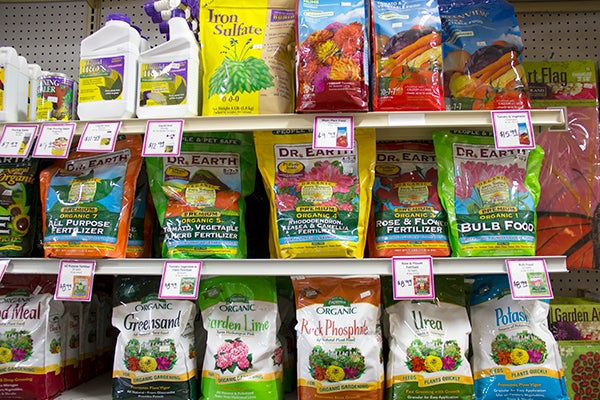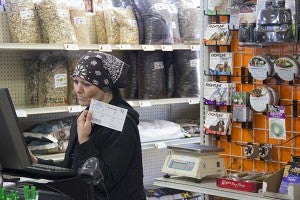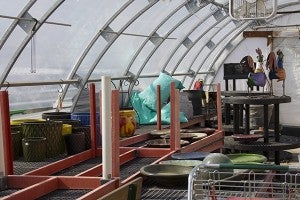Tips for getting ready for eco-friendly springtime gardening
Published 9:33 am Thursday, March 12, 2015

Choose a fertilizer with less nitrogen for your flowers and veggies, and save the high nitrogen ones for your lawn, says the Seed House’s Rodney Hunt. – Elizabeth Hustad/Albert Lea Tribune
By Elizabeth Hustad, Albert Lea Tribune
Darla Robbins is busy these days getting ready for springtime gardening. Usually she helps look after the plants at the Albert Lea Seed House, but right now the greenhouse is awaiting the spring thaw, its temporary plastic covering waving in the wind at one corner. But the peat moss is piled high outside, and the pots are lined up on the greenhouse tables.

The Seed House’s Darla Robbins says you don’t have to go spray-free to have an eco-friendly garden. – Elizabeth Hustad/Albert Lea Tribune
As you get ready for planting season, you might want to think about adding more than flowers this year.
Apart from being cost-effective, growing fruits and vegetables yourself can be beneficial to the environment. Think of it as eating hyper-local. And even without an expansive lawn, growing veggies is still an option.
“I’d like to see more young people garden,” said the Seed House’s Rodney Hunt, who has been gardening for nearly 40 years and said he believes if everyone grew even a little of their own produce, the environment would benefit.
A planter with a water reservoir doesn’t take up much space, but it lends itself well to growing a variety of different vegetables, said Hunt. Hunt also uses trellises for vegetables like cucumbers.
But how do you start a vegetable garden and make sure it’s at its healthiest for both you and the environment?
Nancy Cooper, a gardener in Gordonsville who came to the garden shop for seeds, said she uses natural soils and no sprays for her vegetables. But having an eco-friendly garden doesn’t have to mean a spray-free garden.

Waiting for spring: The pots and peat moss are here, but still no plants in the greenhouse at the Albert LeaSeed House. – Elizabeth Hustad/Albert Lea Tribune
A lot of sprays, like insecticides are only an issue when people use them while the flowers are open, said Robbins.
“You want to be pretty much 100 percent natural when everything’s in blossom, because if you start doing insecticides you’re going to kill the bees, and then you’re not going to get anything because they won’t be able to pollinate it if they’re not around.”
Choosing a good fertilizer is also important, Hunt said. Using one with a lower nitrogen content for flowers and most vegetables is best; the higher nitrogen fertilizers are good for grasses and can help make your lawn greener as well as encourage grass vegetables like corn, he said.
But avid gardeners beware: It’s still too early to start. “Wait until the ground is dried up and the grass is up and growing,” said Hunt. “Don’t try and rake early because you’ve got young plants.”
Hunt gave similar advice for prepping gardens, saying that people should wait until the soil has dried out before mixing in the fertilizer.
Can’t wait? It’s perfectly okay to plant indoor seeds any time now.
Tips for a healthier (and more eco-friendly) garden
• Wait until the ground is dry to start raking. A squeeze test of soil can help you here: If water leaks out, it’s too wet to rake, said the Seed House’s Rodney Hunt.
• Choose a lower nitrogen content for fertilizers you use on veggies or flowers and save the higher nitrogen ones for your yard and grass plants like corn.
• If you’re adding phosphorus to your garden soil, make sure to work it in instead of sprinkling the fertilizer on the top. Leaving it on top will only run off and work into the rivers and lakes instead of your plants.
• Don’t underestimate how much damage weeds can do. Some, like Creeping Charlie, have long underground roots that sprout up in multiple places, cautioned Robbins. Also make sure to deadhead your flowers to promote new blooms.
• Only use insecticides after fruit flowers have fallen off.


